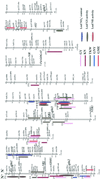Towards a better understanding of the genetic and physiological basis for nitrogen use efficiency in maize
- PMID: 11244107
- PMCID: PMC65606
- DOI: 10.1104/pp.125.3.1258
Towards a better understanding of the genetic and physiological basis for nitrogen use efficiency in maize
Abstract
To enhance our understanding of the genetic basis of nitrogen use efficiency in maize (Zea mays), we have developed a quantitative genetic approach by associating metabolic functions and agronomic traits to DNA markers. In this study, leaves of vegetative recombinant inbred lines of maize, already assessed for their agronomic performance, were analyzed for physiological traits such as nitrate content, nitrate reductase (NR), and glutamine synthetase (GS) activities. A significant genotypic variation was found for these traits and a positive correlation was observed between nitrate content, GS activity and yield, and its components. NR activity, on the other hand, was negatively correlated. These results suggest that increased productivity in maize genotypes was due to their ability to accumulate nitrate in their leaves during vegetative growth and to efficiently remobilize this stored nitrogen during grain filling. Quantitative trait loci (QTL) for various agronomic and physiological traits were searched for and located on the genetic map of maize. Coincidences of QTL for yield and its components with genes encoding cytosolic GS and the corresponding enzyme activity were detected. In particular, it appears that the GS locus on chromosome 5 is a good candidate gene that can, at least partially, explain variations in yield or kernel weight. Because at this locus coincidences of QTLs for grain yield, GS, NR activity, and nitrate content were also observed, we hypothesize that leaf nitrate accumulation and the reactions catalyzed by NR and GS are coregulated and represent key elements controlling nitrogen use efficiency in maize.
Figures

Similar articles
-
An approach to the genetics of nitrogen use efficiency in maize.J Exp Bot. 2004 Feb;55(396):295-306. doi: 10.1093/jxb/erh006. J Exp Bot. 2004. PMID: 14739258 Review.
-
Genetic and physiological analysis of germination efficiency in maize in relation to nitrogen metabolism reveals the importance of cytosolic glutamine synthetase.Plant Physiol. 2002 Dec;130(4):1860-70. doi: 10.1104/pp.009647. Plant Physiol. 2002. PMID: 12481069 Free PMC article.
-
A quantitative genetic study for elucidating the contribution of glutamine synthetase, glutamate dehydrogenase and other nitrogen-related physiological traits to the agronomic performance of common wheat.Theor Appl Genet. 2009 Aug;119(4):645-62. doi: 10.1007/s00122-009-1076-4. Epub 2009 Jun 10. Theor Appl Genet. 2009. PMID: 19513687
-
An integrated statistical analysis of the genetic variability of nitrogen metabolism in the ear of three maize inbred lines (Zea mays L.).J Exp Bot. 2011 Apr;62(7):2309-18. doi: 10.1093/jxb/erq373. Epub 2010 Nov 26. J Exp Bot. 2011. PMID: 21112957
-
[Research advance in nitrogen metabolism of plant and its environmental regulation].Ying Yong Sheng Tai Xue Bao. 2004 Mar;15(3):511-6. Ying Yong Sheng Tai Xue Bao. 2004. PMID: 15228008 Review. Chinese.
Cited by
-
Genome-wide association of carbon and nitrogen metabolism in the maize nested association mapping population.Plant Physiol. 2015 Jun;168(2):575-83. doi: 10.1104/pp.15.00025. Epub 2015 Apr 27. Plant Physiol. 2015. PMID: 25918116 Free PMC article.
-
The Genetic Dissection of Nitrogen Use-Related Traits in Flax (Linum usitatissimum L.) at the Seedling Stage through the Integration of Multi-Locus GWAS, RNA-seq and Genomic Selection.Int J Mol Sci. 2023 Dec 18;24(24):17624. doi: 10.3390/ijms242417624. Int J Mol Sci. 2023. PMID: 38139451 Free PMC article.
-
Heterologous expression of ATG8c from soybean confers tolerance to nitrogen deficiency and increases yield in Arabidopsis.PLoS One. 2012;7(5):e37217. doi: 10.1371/journal.pone.0037217. Epub 2012 May 22. PLoS One. 2012. PMID: 22629371 Free PMC article.
-
QTL mapping for seedling traits in wheat grown under varying concentrations of N, P and K nutrients.Theor Appl Genet. 2012 Mar;124(5):851-65. doi: 10.1007/s00122-011-1749-7. Epub 2011 Nov 17. Theor Appl Genet. 2012. PMID: 22089330
-
Overexpression of the Maize ZmNLP6 and ZmNLP8 Can Complement the Arabidopsis Nitrate Regulatory Mutant nlp7 by Restoring Nitrate Signaling and Assimilation.Front Plant Sci. 2017 Oct 5;8:1703. doi: 10.3389/fpls.2017.01703. eCollection 2017. Front Plant Sci. 2017. PMID: 29051766 Free PMC article.
References
-
- Agrama HAS, Zacharia AG, Said M, Tuinstra M. Identification of quantitative trait loci for nitrogen use efficiency in maize. Mol Breed. 1999;5:187–195.
-
- Becker TW, Carrayol E, Hirel B. Glutamine synthetase and glutamate dehydrogenase isoforms in maize leaves: localization, relative proportion and their role in ammonium assimilation or nitrogen transport. Planta. 2000;211:800–806. - PubMed
-
- Becker WA. Manual of quantitative genetics. Ed 4. WA: Academic Enterprises, Pullman; 1984.
-
- Below FE. Nitrogen metabolism and crop productivity. In: Pessarakli M, editor. Handbook of Plant and Crop Physiology. New York: Marcel Dekker; 1995. pp. 275–301.
-
- Below FE, Cazetta JO, Seebauer JR. Physiology and Modeling Kernel Set in Maize. Crop Science Society of America and American Society of Agronomy special publication number 29. 2000. Carbon/nitrogen interactions during ear and kernel development of maize.
MeSH terms
Substances
LinkOut - more resources
Full Text Sources
Other Literature Sources

